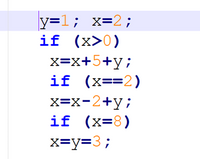
Database System Concepts
7th Edition
ISBN: 9780078022159
Author: Abraham Silberschatz Professor, Henry F. Korth, S. Sudarshan
Publisher: McGraw-Hill Education
expand_more
expand_more
format_list_bulleted
Question
In Java find the value of x , y after the statements are executed:
(statements are in picture)

Transcribed Image Text:The image contains the following code written in a programming language, likely resembling C or C++:
```c
y = 1;
x = 2;
if (x > 0)
x = x + 5 + y;
if (x == 2)
x = x - 2 + y;
if (x == 8)
x = y = 3;
```
### Explanation:
1. **Initialization:**
- `y` is assigned the value `1`.
- `x` is assigned the value `2`.
2. **First Conditional Statement (`if (x > 0)`):**
- Checks if `x` is greater than `0`. Since `x` is `2`, the condition is true.
- Executes the statement `x = x + 5 + y;`.
- Calculation: `x = 2 + 5 + 1`, resulting in `x = 8`.
3. **Second Conditional Statement (`if (x == 2)`):**
- Checks if `x` equals `2`. Since `x` is `8`, the condition is false.
- The corresponding block of code is not executed.
4. **Third Conditional Statement (`if (x == 8)`):**
- Checks if `x` equals `8`. Since `x` is indeed `8`, the condition is true.
- Executes the statement `x = y = 3;`.
- Both `x` and `y` are assigned the value `3`.
This sequence of code evaluates a set of conditions and performs arithmetic operations, demonstrating conditional execution and variable manipulation.
Expert Solution
arrow_forward
Explanation
Here we have x=2 and y=1.
Then, we have an if statement with condition x greater than 0, which is true, and hence the value of x gets updated to x+5+y.
Next, we have another if statement with condition x equals 2, which is false as x is updated to 8.
Next, we have another if statement with the condition x equals 8 which is true, and both x,y gets updated.
Step by stepSolved in 2 steps with 1 images

Knowledge Booster
Similar questions
- Use Java. Please see the requirements (good indentation, matching the code EXACTLY how it is below, etc.)arrow_forwardPlease review the image below. Produce the program in C++. Upload screenshots of Code and Output, as well as the source code. 4arrow_forwardName:- Mit (Question-1) Note:- Please type this java code and also need an output for this given Java program.arrow_forward
- Constant Assignment • The compiler will issue an error if you try to change the value of a constant • In Java, we use the final modifier to declare a constant final int x= 69; Add x= x+10 What is the result?arrow_forward(PLEASE USE BASIC JAVA NOT COMPLEX I AM A BEGINNER THANKS) Canadian phone number has the following format: +1 (604) 295- 8959 Area Code= Three digits starting with 2-9Prefix= Three digits starting with 2-9Subscriber= Any four digits 0-9Write a java program, using loops, that asks the user to enter a phone number then if correct print theArea Code, Prefix, and Subscriber numbers. If not correct, print what is wrong. Sample run:Enter a number or -99 to quit: +1 (604) 277-9999The number is correct with area code: 604, prefix 277, and subscriber 9999Enter a number or -99 to quit: 1 (104) 277-0123Country code doesn’t start with + and area code doesn’t start with a 2-9 number.arrow_forwardIndicate whether or not the following is a valid Java statement. Whenever the statement is invalid, briefly explain why. int count- 12.567:arrow_forward
arrow_back_ios
arrow_forward_ios
Recommended textbooks for you
 Database System ConceptsComputer ScienceISBN:9780078022159Author:Abraham Silberschatz Professor, Henry F. Korth, S. SudarshanPublisher:McGraw-Hill Education
Database System ConceptsComputer ScienceISBN:9780078022159Author:Abraham Silberschatz Professor, Henry F. Korth, S. SudarshanPublisher:McGraw-Hill Education Starting Out with Python (4th Edition)Computer ScienceISBN:9780134444321Author:Tony GaddisPublisher:PEARSON
Starting Out with Python (4th Edition)Computer ScienceISBN:9780134444321Author:Tony GaddisPublisher:PEARSON Digital Fundamentals (11th Edition)Computer ScienceISBN:9780132737968Author:Thomas L. FloydPublisher:PEARSON
Digital Fundamentals (11th Edition)Computer ScienceISBN:9780132737968Author:Thomas L. FloydPublisher:PEARSON C How to Program (8th Edition)Computer ScienceISBN:9780133976892Author:Paul J. Deitel, Harvey DeitelPublisher:PEARSON
C How to Program (8th Edition)Computer ScienceISBN:9780133976892Author:Paul J. Deitel, Harvey DeitelPublisher:PEARSON Database Systems: Design, Implementation, & Manag...Computer ScienceISBN:9781337627900Author:Carlos Coronel, Steven MorrisPublisher:Cengage Learning
Database Systems: Design, Implementation, & Manag...Computer ScienceISBN:9781337627900Author:Carlos Coronel, Steven MorrisPublisher:Cengage Learning Programmable Logic ControllersComputer ScienceISBN:9780073373843Author:Frank D. PetruzellaPublisher:McGraw-Hill Education
Programmable Logic ControllersComputer ScienceISBN:9780073373843Author:Frank D. PetruzellaPublisher:McGraw-Hill Education

Database System Concepts
Computer Science
ISBN:9780078022159
Author:Abraham Silberschatz Professor, Henry F. Korth, S. Sudarshan
Publisher:McGraw-Hill Education

Starting Out with Python (4th Edition)
Computer Science
ISBN:9780134444321
Author:Tony Gaddis
Publisher:PEARSON

Digital Fundamentals (11th Edition)
Computer Science
ISBN:9780132737968
Author:Thomas L. Floyd
Publisher:PEARSON

C How to Program (8th Edition)
Computer Science
ISBN:9780133976892
Author:Paul J. Deitel, Harvey Deitel
Publisher:PEARSON

Database Systems: Design, Implementation, & Manag...
Computer Science
ISBN:9781337627900
Author:Carlos Coronel, Steven Morris
Publisher:Cengage Learning

Programmable Logic Controllers
Computer Science
ISBN:9780073373843
Author:Frank D. Petruzella
Publisher:McGraw-Hill Education